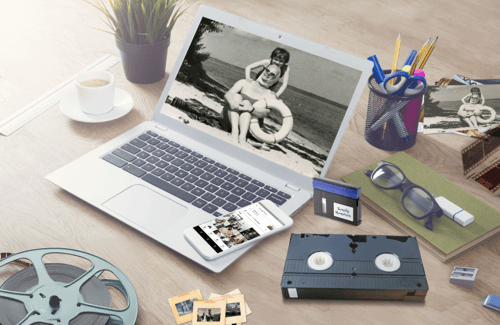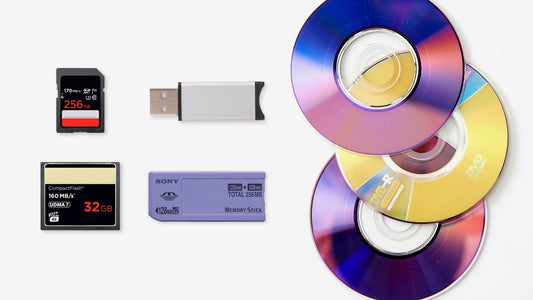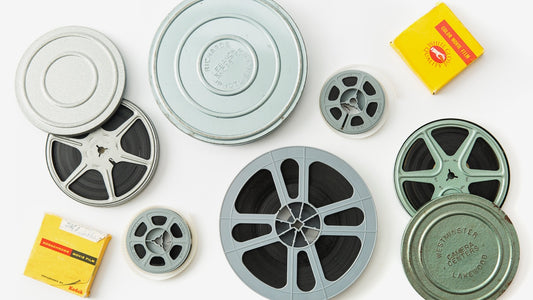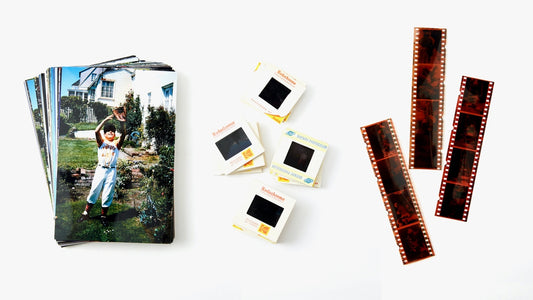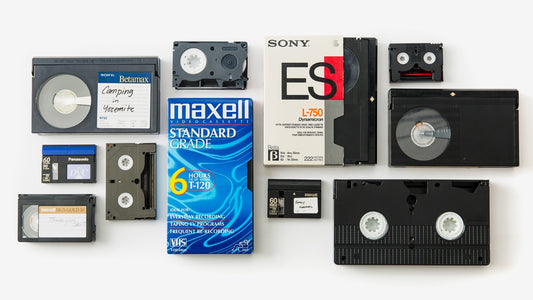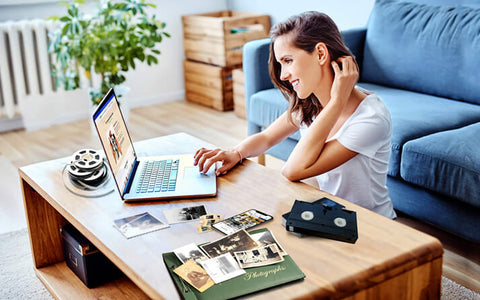That box of old VHS tapes in the closet feels heavy, but it’s holding something precious. Inside are the moments photos can’t quite capture—the sound of your grandpa’s laugh, your childhood home on Christmas morning, the toast at a wedding. The only way to see them again is to convert VHS to digital. This process transforms those bulky, fading tapes into lasting digital files you can easily watch and share. Think of this guide as your friendly expert. We’ll show you exactly what you need for a DIY project or how to find a professional service you can trust.
Key Takeaways
- Protect your memories from time: VHS tapes deteriorate, but digital files don't. Digitizing your home movies, whether yourself or with a service, safeguards those precious moments.
- Enjoy and share with ease: Digital videos are accessible on any modern device and simple to share with family and friends, no matter where they are.
- Find the right path: DIY offers control and can be budget-friendly, while professional services provide convenience and expertise. Choose the approach that best suits your needs and resources.
What Does It Mean to Convert VHS to Digital?
VHS to digital conversion simply means transferring the content of your old VHS tapes onto a modern digital format. Think of it like moving your home movies from bulky boxes in the attic to neatly organized files on your computer, a USB drive, or even cloud storage. This lets you watch your precious memories on current devices like laptops, smartphones, and smart TVs. Legacybox offers a helpful overview of VHS conversion.
The process involves a few key components. You'll need a VCR to play your tapes. A special device called a "capture device" converts the analog video signal from the VCR into a digital format. Finally, you'll use software on your computer to save the digital video files and make any edits. This Reddit discussion offers insights into VHS digitization. It's more straightforward than it sounds!
Digitizing your VHS tapes is crucial for preserving irreplaceable moments. VHS tapes degrade over time, and those precious memories can become lost. Converting them to digital is like giving them a new lease on life. Plus, it makes sharing those special moments with family and friends much easier. Nostalgic Media discusses the importance of preserving memories. You can do it yourself or use a professional service. This USA Today article compares DIY and professional VHS conversion.
Why Should You Convert Your VHS Tapes to Digital?
Let's be honest, those boxes of VHS tapes tucked away in the attic or basement aren't getting any younger. Digitizing your old home videos isn't just about updating the format; it's about safeguarding precious memories for generations to come. Here's why making the switch from VHS to digital is so important:
Stop Your Memories from Fading
Time takes its toll on everything, and VHS tapes are no exception. They're susceptible to wear and tear, degrading over time and potentially losing those precious moments forever. Think faded colors, distorted sound, and even the dreaded tape breakage. Converting your VHS tapes to digital files creates a much more permanent record, protecting them from the ravages of time. As USA Today points out in their article on converting VHS tapes, this process ensures your cherished moments aren't lost to deterioration. It's like giving your memories a new lease on life.
The 15-Year Lifespan of a VHS Tape
VHS tapes weren't built to last forever. They have a surprisingly short lifespan, with noticeable degradation often starting around the 15-year mark. As the team at Legacybox notes, old VHS tapes are breaking down, which means the clock is ticking on those home movies. This isn't just a slight dip in quality; we're talking about faded colors, muffled audio, and magnetic tape that can become so brittle it snaps. On top of that, finding a working VCR that won't damage your tapes is a challenge in itself. This physical decay is why digitizing is so critical. As USA Today highlights, VHS tapes degrade over time, putting your irreplaceable family moments at risk. Entrusting your tapes to a professional video transfer service ensures they are handled with care, preserving them before it's too late.
Easily Access and Share Your Videos
Remember the last time you wanted to watch an old home video? Did you have to dust off the VCR, hoping it still worked? Digitizing your tapes eliminates the need for outdated equipment. Your memories become instantly accessible on modern devices like computers, smartphones, and tablets. Plus, sharing becomes a breeze. No more mailing bulky tapes—simply send a digital file to family and friends near and far. Tech Bullion highlights this benefit in their discussion on transforming memories with digitization, emphasizing how it makes sharing easy.
Reclaim Your Shelf Space
Let's face it, VHS tapes are bulky. Digitizing your collection frees up valuable physical space in your home. Those boxes taking up residence in your closet or attic can be replaced with a single hard drive or cloud storage account. The California Learning Resource Network discusses this advantage in their guide to VHS conversion, noting how digital files simplify storage and organization. Plus, finding the exact video you want to watch becomes much easier when you're browsing digital files instead of sifting through a mountain of tapes.
Your DIY VHS Conversion Toolkit
Digitizing your VHS tapes at home can be a rewarding project. Before you start, gather the necessary equipment. Having everything prepared will make the process much smoother.
A Working VCR Player
First, you'll need a working VCR to play your tapes. You might be surprised to find one tucked away in a closet or attic. If not, check local thrift stores, online marketplaces like eBay or Facebook Marketplace, or even garage sales.
An Analog-to-Digital Capture Device
Next, you'll need a capture device to convert the analog signal from your VCR into a digital format. Several options exist, each with its own pros and cons:
- Combination VHS-to-DVD Recorder: These devices allow you to record directly onto a DVD. You can then rip the DVD to a digital file using software like HandBrake. This adds an extra step, but it can be a good option if you want a physical DVD backup as well.
- Direct-to-Digital Converter: These devices typically record to a USB flash drive or SD card as an MP4 file. This simplifies the process, as you don't need a computer during the recording process. ClearClick offers a few different models.
- Computer Capture Card: Devices like the Elgato Video Capture connect to your computer via USB and offer user-friendly software for digitizing. These are compatible with both Macs and PCs.
Popular and Budget-Friendly Converters
Finding the right converter doesn't have to be complicated or break the bank. There are a few popular routes you can take, and the best one for you really just depends on how hands-on you want to be. Each method is designed to bridge the gap between your old tapes and your new devices. Let's look at a few common choices that can help you get started on your digitization project without a huge investment.
- Combination VHS-to-DVD Recorder: This is an all-in-one machine that records your VHS tape directly onto a DVD. Once you have the disc, you can use free software like HandBrake to pull the video onto your computer. It's a great option if you also want a physical DVD backup of your memories.
- Direct-to-Digital Converter: If you'd rather skip using a computer for the recording part, this is for you. Devices from brands like ClearClick record your video straight from the VCR to a USB drive or SD card as a ready-to-use MP4 file. It’s a very user-friendly method.
- Computer Capture Card: For a more tech-involved project, a capture card like the Elgato Video Capture is a popular choice. It connects your VCR to your computer and comes with software to walk you through the process on either a Mac or PC.
These tools can all get the job done, and many people find the DIY process really rewarding. You can even find helpful tips from others who have done it themselves, like in this Reddit discussion. However, the process does take time and a bit of patience. If you'd rather skip the setup and troubleshooting, using a professional service is a fantastic alternative. At YesVideo, we handle the entire video transfer process by hand, so you can be sure your memories are treated with care.
Connecting It All: Cables and Adapters
You'll need RCA cables (the red, white, and yellow ones) to connect your VCR to the capture device. These cables transmit the audio and video signals. Make sure you have a set on hand, or pick some up at an electronics store.
Your Computer and Capture Software
Finally, you'll need a computer to store the digital files. Video files can be large, so ensure you have enough hard drive space. Some capture devices include software, while others might require third-party applications. HandBrake is a free, open-source option for ripping DVDs and converting video files. OBS Studio is another free option, useful for recording directly from a capture card.
Recommended Free Software Options
Once your hardware is connected, the right software is the final piece of the puzzle. You don't need to spend a fortune to get great results. Here are a few excellent free options to help you capture and polish your home movies:
- OBS Studio: While it's popular with live streamers, OBS Studio is also a fantastic tool for recording video directly from your capture device. It’s a versatile choice that works on both Windows and Mac, giving you a high-quality digital file to work with from the start.
- HandBrake: If you chose a VHS-to-DVD recorder for your setup, HandBrake is your next best friend. This free program is brilliant for "ripping" those DVDs, converting them into modern digital files that you can easily save and watch on any device.
- Shotcut: After you've digitized your footage, you might want to clean it up. Shotcut is a free, open-source video editor that’s perfect for trimming unwanted sections, adding simple transitions, or adjusting the audio. It’s a great way to give your home movies a little extra polish before sharing them.
How to Convert VHS to Digital: A Step-by-Step Guide
This section provides a general overview of the process. If you’re looking for a hassle-free experience and top-notch quality, consider professional digitization services (which we'll discuss later).
Step 1: Connect Your Equipment
First, gather your equipment. You'll need a working VCR to play your tapes, a video capture device to connect your VCR to your computer, the correct cables (usually RCA cables), and a computer to store the digital files. Connecting everything correctly is key. Make sure your VCR and capture device are powered on and that your computer recognizes the capture device. You can find several video capture devices on the market, each with its own setup instructions. Popular choices include the Elgato Video Capture Device and the ClearClick Video to Digital Converter.
Step 2: Capture and Record Your Video
Once your equipment is set up, connect the RCA cables from your VCR's output to the input of your capture device. Then, connect the capture device to your computer using a USB cable. Launch the software that came with your capture device (or a compatible third-party option like OBS Studio). Start playing your VHS tape and simultaneously begin recording within the software. The process is fairly straightforward, but it does require the tape to play in real-time, so set aside enough time for the entire recording.
Step 3: Edit and Save Your Digital Video
After capturing the video, you can edit the digital file using video editing software. This allows you to trim unwanted footage, adjust the brightness and contrast, and even add transitions or titles. Numerous video editing programs are available, ranging from free options like iMovie (for Mac users) to more advanced software like Adobe Premiere Pro. Once you're satisfied with the final product, save the file in a widely compatible format like MP4. Consider saving your digitized videos to both your computer's hard drive and an external hard drive or cloud storage service for safekeeping.
Choosing a Professional VHS Conversion Service
If the DIY route feels overwhelming, or you're short on time, several companies specialize in VHS to digital conversion. These services handle everything for you, from shipping to the actual conversion process. Here are a few popular options:
YesVideo
YesVideo is a trusted name in home movie transfer, with over 20 years of experience. They offer various digitization options, including converting VHS tapes to DVDs, digital downloads, or USB drives. All conversions are done by hand in the USA, ensuring quality and care. YesVideo also offers services for film transfer, photo scanning, and more, making it a one-stop shop for preserving all your family memories.
Handling a Wide Range of Formats
Your memory collection probably doesn't stop at VHS tapes. You might also have boxes of old film reels, stacks of photo prints, or even entire photo albums you want to save. This is where a professional service really simplifies things. Instead of figuring out how to digitize each format yourself, you can send everything to one place. Services like YesVideo are set up to handle a wide range of media, from video transfer to film reels and photo scanning. They can even tackle entire photo albums, ensuring every part of your family's history is preserved together. It’s a convenient way to get a complete digital library of your most cherished moments.
A Focus on Safety and Quality
Handing over your one-of-a-kind memories can feel nerve-wracking, which is why reputable services prioritize safety and quality above all else. Many companies provide sturdy, crush-proof boxes for shipping and use barcode tracking to monitor your order every step of the way. At YesVideo, we understand how precious these items are. That's why every single order is processed by our trained technicians by hand, right here in the USA. This hands-on approach ensures your memories receive the care and attention they deserve, resulting in a high-quality digital transfer. And, of course, all your original tapes, photos, and films are safely returned to you along with your new digital copies.
Legacybox
Legacybox provides a convenient way to digitize your VHS collection. They offer several package options to fit different needs and budgets, with pricing based on the number of tapes you want to convert. You can choose to receive your digitized videos on DVDs, thumb drives, or via digital download. Legacybox also handles other formats like film reels, photos, and audio cassettes.
Understanding the Kit-Based Pricing
Legacybox structures its pricing around kits of different sizes, which are based on the number of "items" you want to digitize. It's helpful to know that they define one "item" as a single tape, one film reel, or a set of 25 photos. This makes it easier to estimate which kit you'll need. Their options range from a small starter kit for two items up to a large "Trunk" that can handle 40 items. It's worth noting that their website often features promotions, so the final price you see might reflect a discount. Always check their VHS conversion page for the most current pricing before you order.
The Mail-In Process and Timelines
The process is designed to be straightforward. Legacybox sends you a crush-proof box that includes everything you need to safely pack your media. Inside, you'll find a welcome guide with instructions, special barcodes to track each of your tapes, and a pre-paid UPS shipping label for sending it back. Once you've packed your memories, you just drop the box off at a UPS location. The standard turnaround time is about four to six weeks. If you're on a tighter schedule, they offer expedited processing (about three to four weeks) and a rush option (about 10 business days) for an additional fee, which is great if you need your memories digitized for a specific event.
Safety Guarantees and Digital Backups
Handing over irreplaceable memories can feel nerve-wracking, so Legacybox offers a couple of features for peace of mind. Their "Added-Safety Protection" includes a $1,000 guarantee, backed by UPS Capital, in the unfortunate event your package is lost during shipping. This adds a significant layer of security to the process. Additionally, once your tapes are digitized and your order is complete, they keep a digital backup of your files on their servers for 30 days. This gives you a safety net in case anything happens to your digital copies or original media on their return journey, ensuring your memories are protected.
Big-Box Retailer Services (Costco, Walmart, CVS)
Several retail stores offer VHS to digital conversion services, often at competitive prices. Costco Photo Center is one such option, typically providing DVD conversions with a digital copy included. Walmart and CVS also offer similar services through their photo centers, making it easy to drop off your tapes while running errands. Check with your local store for pricing and availability. Walmart Photo offers a range of digital transfer services in Canada. For US customers, check your local CVS Photo for details on their home movie transfer services.
Pricing and Supported Formats
When you start comparing professional services, you'll notice that pricing can vary quite a bit. Many big-box retailers charge per item. For instance, CVS Photo starts its pricing at $25.99 to convert up to two hours of video from two tapes onto a single DVD, while a USB drive starts at $34.99. Walgreens Photo begins its videotape digitization at $34.99 per tape. In contrast, services like Legacybox use a kit-based model where you choose a box that holds a set number of items. Their starter kit, for example, holds two items for about $70. This approach can be a great fit if you have a mix of media, like tapes and film reels, that you want to digitize together.
Understanding Output Restrictions
Just as important as the price is knowing how you’ll get your memories back. The output options can differ significantly between services, so it’s worth looking into before you commit. Some companies offer great flexibility. CVS Photo lets you choose between a DVD, Blu-ray, or USB, and they also include a digital copy for you to download. Legacybox also provides several choices, including a thumb drive, a disc set, or a digital download. However, some retailers are more restrictive. Walgreens, for example, only transfers videotapes and film to DVD, while photos and negatives go exclusively to a USB drive. At YesVideo, we provide a digital copy of your memories with every order, accessible through a permanent cloud account. You can also add a USB drive or DVD set, giving you the best of both worlds: instant online access and a physical copy for safekeeping.
Boutique and Local Digitization Services
Beyond the big names, several other companies focus specifically on digitizing memories. iMemories, Southtree, and EverPresent are a few examples. These services often offer a wider range of output options, including Blu-ray and cloud storage, and may provide additional features like video editing and restoration. However, they can sometimes be more expensive than retail options. Researching each company's offerings will help you find the best fit for your needs and budget.
DIY vs. Pro: Which VHS Conversion Method Is Best?
So, you're ready to convert those VHS tapes to digital. Great! Now for the big decision: do it yourself (DIY) or use a professional service? Both options have their pros and cons. The best choice depends on your budget, technical skills, available time, and the quality you want. Let's break it down to help you decide.
Comparing the Cost
Cost is often the first thing we think about. Professional conversion services typically charge between $20 and $35 per tape, sometimes more depending on the provider and any add-on services. For example, some services range from $7.50 to almost $35 per tape, depending on your needs (Nostalgic Media pricing). If you have many tapes, this can get expensive quickly. DIY involves the upfront cost of a video capture device and software, usually around $50–$150. If you already have a computer, this initial investment might be less than having even a few tapes professionally converted. However, also consider the value of your time, which we'll discuss next.
When Professional Services Make Financial Sense
While the DIY route can be cost-effective for one or two tapes, the financial equation shifts when you have a large collection. The biggest hidden cost of DIY is your time. Since tapes must be recorded in real-time, digitizing a dozen two-hour tapes means at least 24 hours of recording, not including setup, editing, and troubleshooting. If your time is valuable, or if the thought of managing cables and software feels daunting, a professional service is often the smarter investment. For a predictable per-tape fee, you get convenience, expertise, and peace of mind. Companies like YesVideo specialize in handling your memories with care, using professional-grade equipment to deliver high-quality results without you having to lift a finger.
Considering the Time and Effort
DIY conversion takes time. A one-hour tape takes at least an hour to convert, plus the time to set up the equipment, edit, and save the files (Reddit thread on VHS Conversion). A large collection turns into a major project. Professional services handle everything for you. You ship your tapes, they handle the conversion, and you get your digital files back. This convenience has a price, but it saves you hours of work.
The Risk of Mailing Your Only Copies
Handing over your only copies of family videos to a mail carrier can feel incredibly nerve-wracking. It’s a common concern, and for good reason—these tapes aren't just old plastic; they're fragile artifacts holding irreplaceable moments. The fear of them getting lost or damaged in transit is completely valid, a sentiment echoed by many who have considered this process. This is why trust is the most important factor when you choose a professional service. Look for a company with a long-standing reputation for quality and care. A trusted partner will have a secure process for tracking and handling your memories, often processing every tape by hand to ensure they are treated with the respect they deserve.
Will the Quality Be Different?
Quality is key for preserving memories. While DIY methods can produce decent results, professional services often use better equipment and expertise, leading to better video and audio. VHS tapes have inherent limitations; you won't get perfect HD no matter what (Reddit thread on VHS Conversion). However, professionals can often optimize the conversion for the best possible result, addressing issues like color and audio (Convert My Tape troubleshooting tips). With DIY, the final quality depends mostly on your equipment and technical skills. If you want the best quality and have the budget, professional conversion is generally the better option.
Managing Your Quality Expectations
When you decide to convert your VHS tapes, it's important to have realistic expectations about the final video quality. VHS is an inherently low-resolution format, and the magnetic tape itself degrades over time. Digitization is a fantastic way to preserve what's left of your memories, but it can't magically create a high-definition picture from a standard-definition source. As one user in a Reddit discussion on the topic notes, "The quality of VHS tapes is already low, so don't expect super clear digital videos." While DIY methods are great for preservation, professional services often use superior equipment and techniques to get the cleanest possible transfer, which can make a noticeable difference in the final video and audio. If maximizing quality is your main goal, investing in a professional service that understands how to handle fragile, aging media is your best bet.
Advanced DIY Methods for Experts
If you're comfortable with technology and enjoy a good project, you can explore more advanced DIY methods for potentially better results. This usually involves using a computer-based capture device. The process requires you to connect your VCR to your computer with a USB capture card, then use software to record the video directly to your hard drive. As detailed in a helpful Reddit thread, popular devices like the Elgato Video Capture are known for being user-friendly and compatible with both Mac and PC. For those who are truly dedicated, there are even more complex options like 'VHS-Decode,' which can produce exceptional quality but demand a powerful computer and a significant amount of storage space. These advanced routes give you more control but also require a bigger investment in time and technical know-how.
Tips for the Best Possible Conversion
How to Prepare Your Tapes for Conversion
Before you even begin the transfer process, take a moment to prepare your VHS tapes. This simple step can prevent hiccups during digitization and ensure a smoother transfer. First, check your tapes for any visible signs of damage like mold or broken casing. If the tape isn't playing correctly, try cleaning the tape and the VHS player heads with a head cleaner. Double-check that all connections, especially the RCA cables, are secure. Loose RCA cables are a common reason for poor video and audio quality.
Choosing the Right File Format
Selecting the right file format is key for preserving video quality. For most people, MP4 strikes a good balance between file size and quality, and it’s widely compatible with most devices and editing software. If you want archival-quality digital copies and have plenty of storage, consider a lossless format—though these files will be much larger. Some VHS to digital converters include software that can guide you. If you're using separate video editing software, like Movavi or iMovie, you'll have more control over the output format and quality settings.
Digital Delivery Options: Cloud, USB, and More
Once your tapes are digitized, you get to choose how you want to receive your new digital memories. Most professional services offer a few convenient options. A popular choice is a digital download, where your videos are stored securely in the cloud for you to access and share from any device. Many companies, including YesVideo, provide a 90-day backup of your files with their video transfer service. Another great option is a USB drive, which gives you a physical, portable copy of your videos that you can easily plug into a computer or smart TV. For those who prefer a more traditional format, you can also get your memories on a DVD, perfect for watching on a standard player or gifting to family members. Choosing the right delivery method ensures your memories are not only preserved but also easy to enjoy and share for years to come.
Always Back Up Your Digital Memories
Once your memories are digitized, protect them with a solid backup plan. The 3-2-1 backup method is a good rule of thumb: keep three copies of your data on two different types of media, with one copy stored offsite. External hard drives, cloud storage, and even DVDs or Blu-ray discs are all viable backup options. Digitizing your tapes offers long-term preservation and easy access, but backing up those digital files ensures your memories are safe, no matter what.
Tips for a Smoother DIY Process
A DIY project can be really satisfying, but it can also come with a few technical hurdles. To help you avoid common frustrations and get the best possible results from your home conversion setup, here are a couple of practical tips. These small steps can make a big difference in the final quality of your digitized videos and save you a lot of time troubleshooting. Of course, if you find the process too technical or simply want to ensure the highest quality for your irreplaceable memories, services like YesVideo are always available to handle the conversion with professional expertise.
Let Your Computer Find the Right Drivers
When you plug in your new video capture device, your first instinct might be to install the software and drivers from the included CD. Hold off on that. Instead, as one user on Reddit suggests, "Try to use the drivers your computer automatically finds for the dongle." Modern operating systems like Windows and macOS are excellent at identifying new hardware and installing the most stable and up-to-date drivers for it. This approach often simplifies the setup process and helps you avoid compatibility issues that can arise from outdated software on a disc. Letting your computer handle it ensures your capture device is recognized correctly, minimizing potential technical headaches before you even press record.
Do a Few Practice Runs First
Before you digitize that irreplaceable tape of your first birthday or your parents' wedding, it’s wise to do a few trial runs. As another helpful Redditor recommends, "It's a good idea to do a few practice runs before converting your most important family videos." Grab a less critical tape—maybe one with old TV shows you recorded—and go through the entire process from start to finish. This gives you a chance to get comfortable with the capture software, test your audio and video levels, and make sure everything is working as expected. A little practice helps you work out any kinks, ensuring you achieve the best possible quality when it's time to preserve your most cherished memories.
Solving Common VHS Conversion Problems
Converting VHS tapes to digital can sometimes feel like navigating a minefield of technical hiccups. But don't worry, most problems have simple solutions. Let's walk through some common challenges and how to fix them.
How to Handle Damaged Tapes
A little TLC can go a long way in reviving your old VHS tapes. First, ensure both your VCR and the capture device are clean. Dust and debris can interfere with playback. If the tape still isn't reading correctly, try cleaning the tape itself with a VHS head cleaner. Sometimes, a good cleaning is all it takes to get those memories back on track. For severely damaged tapes, consider professional VHS repair services to salvage what you can.
Fixing Common Video Quality Issues
If your converted videos aren't as crisp as you'd like, check the settings on your video conversion software. Adjusting the resolution, bitrate, and other parameters can significantly impact the final product. Experiment to find the sweet spot between quality and file size. And remember, software crashes happen. Regularly saving your work can prevent hours of lost effort. If you're using a capture device, ensure it's properly connected and that you've selected the correct input source in your software. Sometimes, outdated drivers can also affect video quality, so consider updating those as well.
Resolving Audio Sync and Quality Problems
Out-of-sync audio can be a real headache. One of the most common culprits is outdated driver software for your capture device. Updating your drivers can often resolve this. If the problem persists, try adjusting the audio settings in your conversion software. Some software allows you to manually synchronize the audio and video tracks. If you've tried these steps and the audio is still giving you trouble, there might be an issue with the audio cables or the VCR itself. Double-check your connections and try playing the tape in a different VCR to isolate the problem.
How to Organize and Share Your New Digital Videos
After digitizing your VHS tapes, organizing and sharing those precious memories is the next step. A little planning goes a long way in ensuring your videos are safe, accessible, and easy to enjoy for years to come.
Choosing Your Digital Storage (Cloud vs. Local)
Digital video files can be quite large, so planning for enough storage space is essential. Think about how many tapes you're converting and the quality settings you used—higher quality means larger files. You'll need sufficient storage on your computer, an external hard drive, or a cloud storage service. Consider researching different storage solutions to find the best fit for your needs.
Building Your Digital Video Archive
Once you’ve digitized your videos, creating a digital archive protects your memories and makes them easy to find. An external hard drive offers a reliable backup, keeping your videos safe even if your computer crashes. Cloud storage services like Google Photos or iCloud are also great options, providing access to your videos from anywhere. YesVideo simplifies this process; their video transfer service includes a Digital Copy and MemoryCloud access, allowing you to view, download, order copies, and save your memories to Google Photos.
Easy Ways to Share Videos with Family
Sharing your digitized videos should be simple and enjoyable. With your videos in a digital format, you can easily share memories with family and friends through email, messaging apps, or social media. For more control over who sees your videos, consider uploading them to YouTube as unlisted or private. This way, you can share a link only with the people you choose. And remember, always back up your digital files to prevent data loss, ensuring your memories are safe and sound for generations to come. You can find helpful tips on backing up your files from various online resources.
Related Articles
- VHS to DVD: Top Transfer Services & DIY Guide – YesVideo
- YesVideo's Video Conversion Service - VHS, Video8, & More
- Digital Media Transfer – YesVideo
- 8mm to DVD: Top Conversion Services & DIY Guide – YesVideo
- YesVideo Digitization Services
Frequently Asked Questions
Why should I digitize my old VHS tapes? VHS tapes degrade over time, putting your precious memories at risk. Digitizing them ensures these moments are preserved in a safe, modern format, easily accessible and shareable with loved ones. Plus, it frees up physical space and eliminates the need for outdated equipment.
What equipment do I need to digitize VHS tapes myself? You'll need a working VCR, a video capture device to convert the analog signal to digital, the appropriate cables (usually RCA cables), and a computer with enough storage space for the digital files. Some capture devices come with software, while others may require third-party applications.
Is it better to digitize VHS tapes myself or use a professional service? It depends on your priorities. DIY is more budget-friendly initially, but it requires time, effort, and some technical know-how. Professional services are more convenient and often deliver higher quality, but they come at a higher cost per tape.
What are the best ways to store and share my digitized videos? External hard drives, cloud storage services, and even DVDs or Blu-ray discs are all good options for storing your digital videos. Sharing is easy via email, messaging apps, social media, or private links on platforms like YouTube. The key is to have a backup plan to protect your precious memories.
What are some common problems during VHS conversion, and how can I fix them? Issues like poor video quality, audio problems, or difficulty playing damaged tapes can often be resolved with simple troubleshooting steps. These include cleaning your equipment and tapes, checking connections, adjusting software settings, and updating drivers. For severely damaged tapes, professional repair services might be necessary.





